- home
- BAKERECIPES
BakeRecipes
Bringing real baking into your home with deliciously simple recipes.
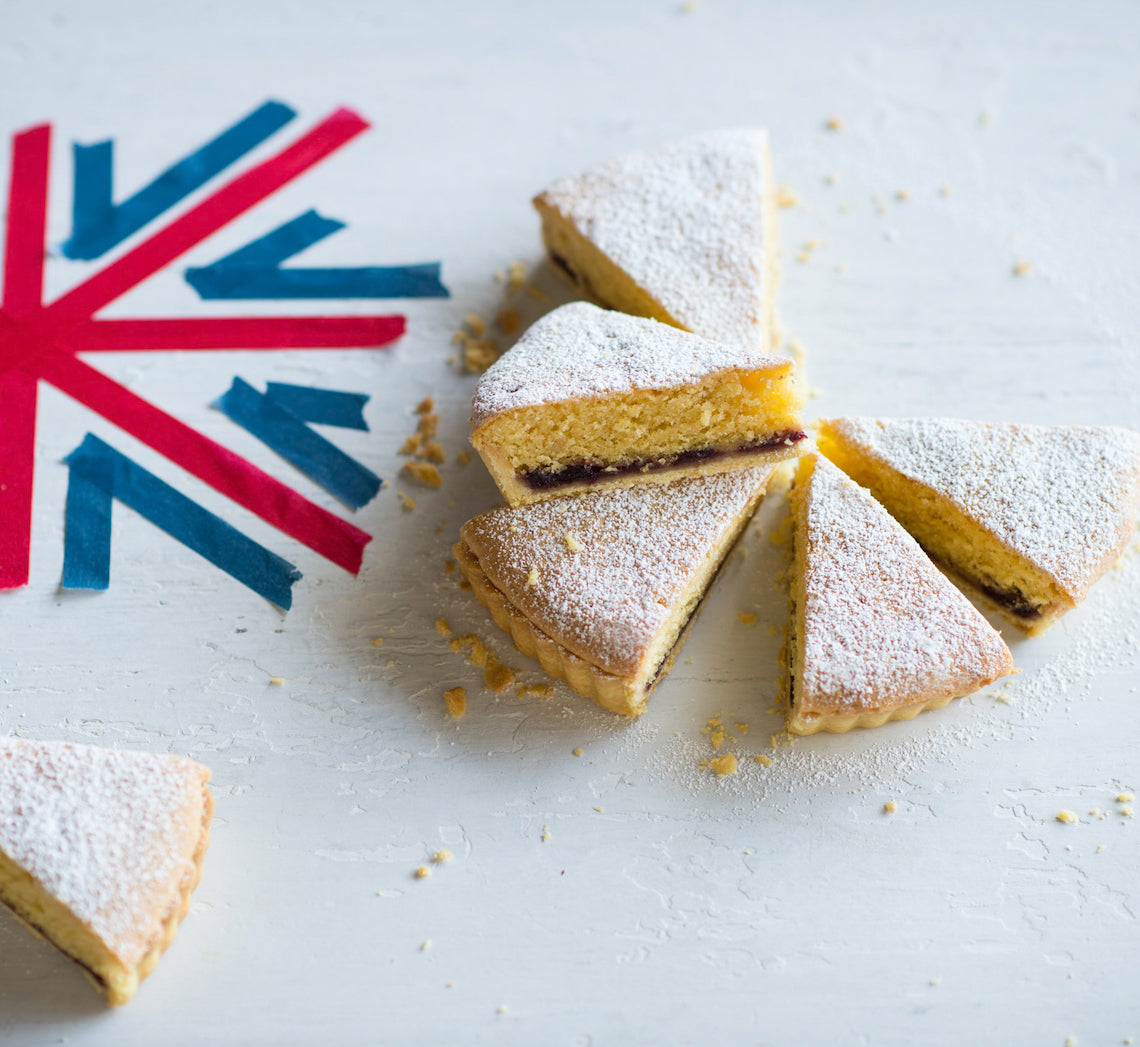
Prep 30minBake 1hr20minMakes about 8-10 serves
Bakewell tart is simply a buttery almond cake in a tart case with a welcome layer of jam in the middle. On first consideration you may not think this combination would work, but take my word for it, it does!
Ingredients
1 quantity sweet shortcrust pastry115g (⅓ cup) raspberry or cherry jam
125g unsalted butter, at room temperature
110g (½ cup) caster sugar
3 drops of almond essence or finely grated zest of 1 lemon
3 eggs
100g (1 cup) almond meal
35g (¼ cup) self-raising flour
icing sugar, to dust
Method
- Preheat oven to 200ºC (180ºC fan-forced).
- Use a lightly floured rolling pin to roll out the pastry on a lightly floured bench top to a round about 3mm thick. Carefully drape the pastry loosely around the rolling pin. Place it over an ungreased round 23cm (base measurement) tart tin with a removable base and then unroll the pastry being careful not to stretch it. Gently lift the edge of the pastry and ease it into the tart tin to line the base and sides and settle it into the corners. Use your fingertips to press it gently into the corners without stretching it. Then, working around the tin, press the pastry into the side using your thumb or finger. Roll the rolling pin over the top of the tart tin to trim any overhanging pastry.
- Place the tart tin on an oven tray. Prick the pastry base with a fork about 12 times. Line the pastry case with baking paper or foil and fill with pastry weights, dried beans or raw rice, making sure they press into the corners and they fill the case. Bake in preheated oven for 15 minutes.
- Remove the pastry case from oven and use the paper or foil to lift the weights out of the case. Return to the oven and bake for a further 15-20 minutes or until cooked through and lightly golden. Remove from the oven.
- Spread the jam evenly over the base of the tart case and set aside. Reduce the oven temperature to 160ºC (140ºC fan-forced).
- Use an electric mixer to beat the butter, sugar and almond essence or lemon zest until pale and creamy. Add the eggs one at a time, beating well after each addition. Combine the almond meal and flour, add to the butter mixture and beat on lowest possible speed until just combined. Spread the mixture evenly over the jam in the tart case.
- Bake in preheated oven for 40-45 minutes or until golden brown and a skewer inserted into the centre comes out clean. Cool in the tin for 10 minutes before removing, dusting with icing sugar and serving warm. Alternatively cool in the tin and serve at room temperature.
Baker's Tips
- This tart will keep in an airtight container at room temperature for up to 2 days.
This recipe is from Anneka's SBS Food online column, Bakeproof: Best of British Baking.
CLICK HERE for more Bakeproof recipes.
Photography by Alan Benson.
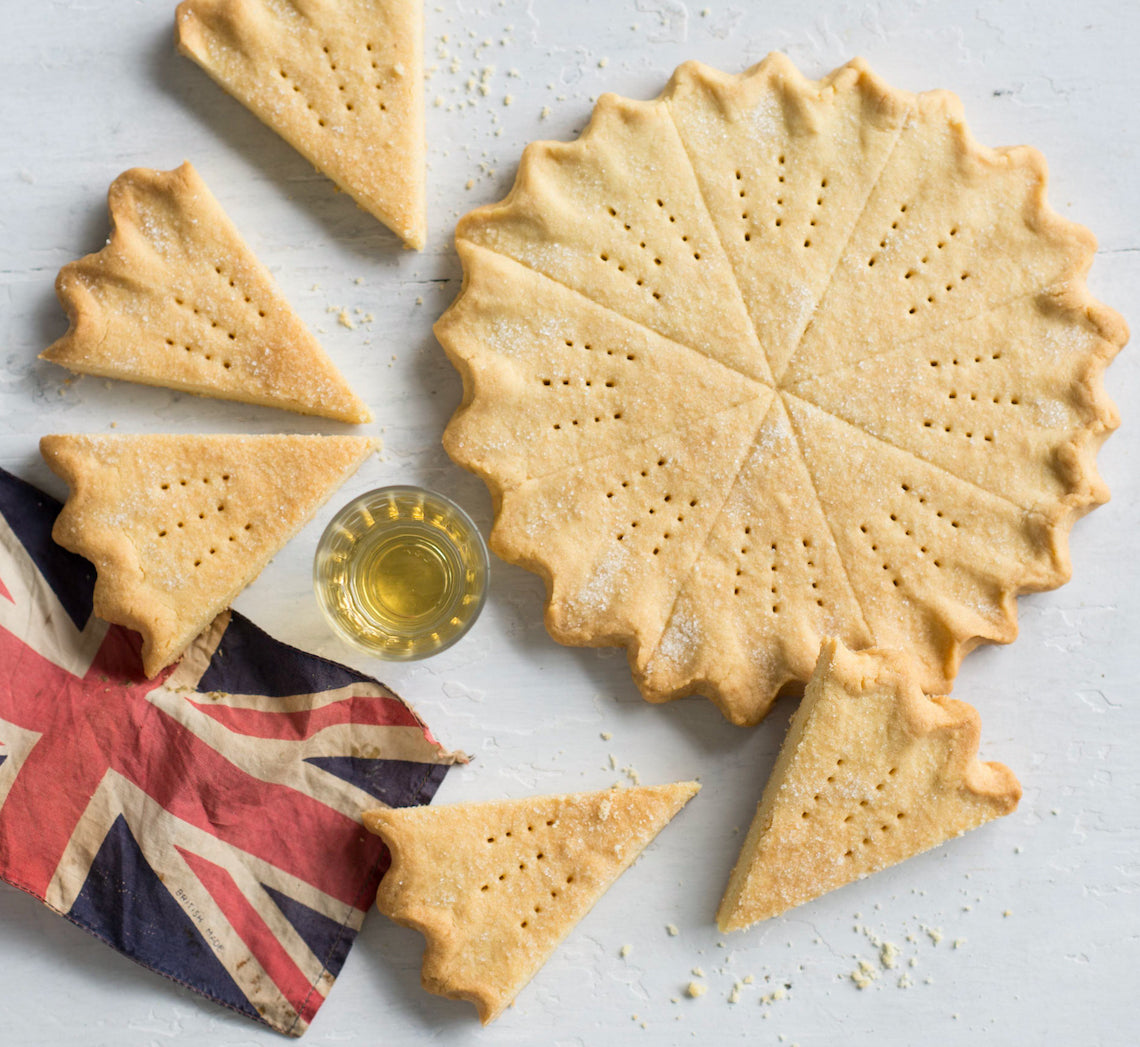
Prep 20minBake 40-45minMakes 16 serves/wedges
Mary Queen of Scots' fondness for shortbread is said to be the reason for its increased popularity in the 1500s. Nowadays it is loved so much there is even a National Shortbread Day on the 6th January each year! The key to good shortbread is slow baking until it is pale golden and cooked through – if over baked, or baked too quickly, it will become slightly bitter in taste due to the ‘burnt’ butter.
Ingredients
250g (9oz) salted butter, cubed and softened slightly
110g (½ cup/4oz) white granulated sugar, plus 1 tablespoon extra to sprinkle
300g (2 cups/10½oz) plain flour
55g (⅓ cup/2oz) rice flour
Method
- Preheat oven to 160ºC/315°F (140ºC/285°F fan-forced). Use a 20cm/4cm cake tin to draw a circle on two separate pieces of non-stick baking paper, turn over and set aside.
- Use an electric mixer to beat the butter and sugar until starting to become pale and creamy, but not too aerated (do not over mix).
- Sift together the plain flour and rice flour, add to the butter mixture and use a wooden spoon and then your hands to mix until evenly combined and a soft dough forms. Divide the dough in half and shape both portions into discs.
- Place each disc in the centre of the marked circles on the baking paper and use a lightly floured rolling pin to roll each out to fill the circles. Use your fingertips to neaten the edges and then pinch the edges to create a decorative edge. Use the baking paper to lift the shortbread rounds onto two oven trays. Sprinkle with the extra sugar, dividing evenly between the rounds. Use a large sharp knife to mark each round into 8 wedges and then use a fork to pick each wedge three times.
- Bake in preheated oven for 40-45 minutes, swapping the trays around half way through baking, or until pale golden and cooked through. Cool on the trays. Cut into wedges to serve.
Baker's Tip
- This shortbread will keep in an airtight container at room temperature for up to 1 week.
Variations
Shortbread Fingers: Use a lightly floured rolling pin to roll a dough portion until about 8mm/3/8in thick. Sprinkle with the extra sugar. Use a large sharp knife to cut into 4cm x 7cm (1½in x 2¾in) fingers, re-rolling and cutting any offcuts. Place on the oven trays about 2cm/¾in apart and use a fork to prick each finger four times. Repeat with the reaming dough portion. Bake in preheated oven for 25-30 minutes, swapping the trays around half way through baking, or until pale golden and cooked through.
Brown Sugar Shortbread: Replace the white granulated sugar with brown sugar or dark brown sugar.
This recipe is from Anneka's SBS Food online column, Bakeproof: Best of British Baking.
CLICK HERE for more Bakeproof recipes.
Photography by Alan Benson.
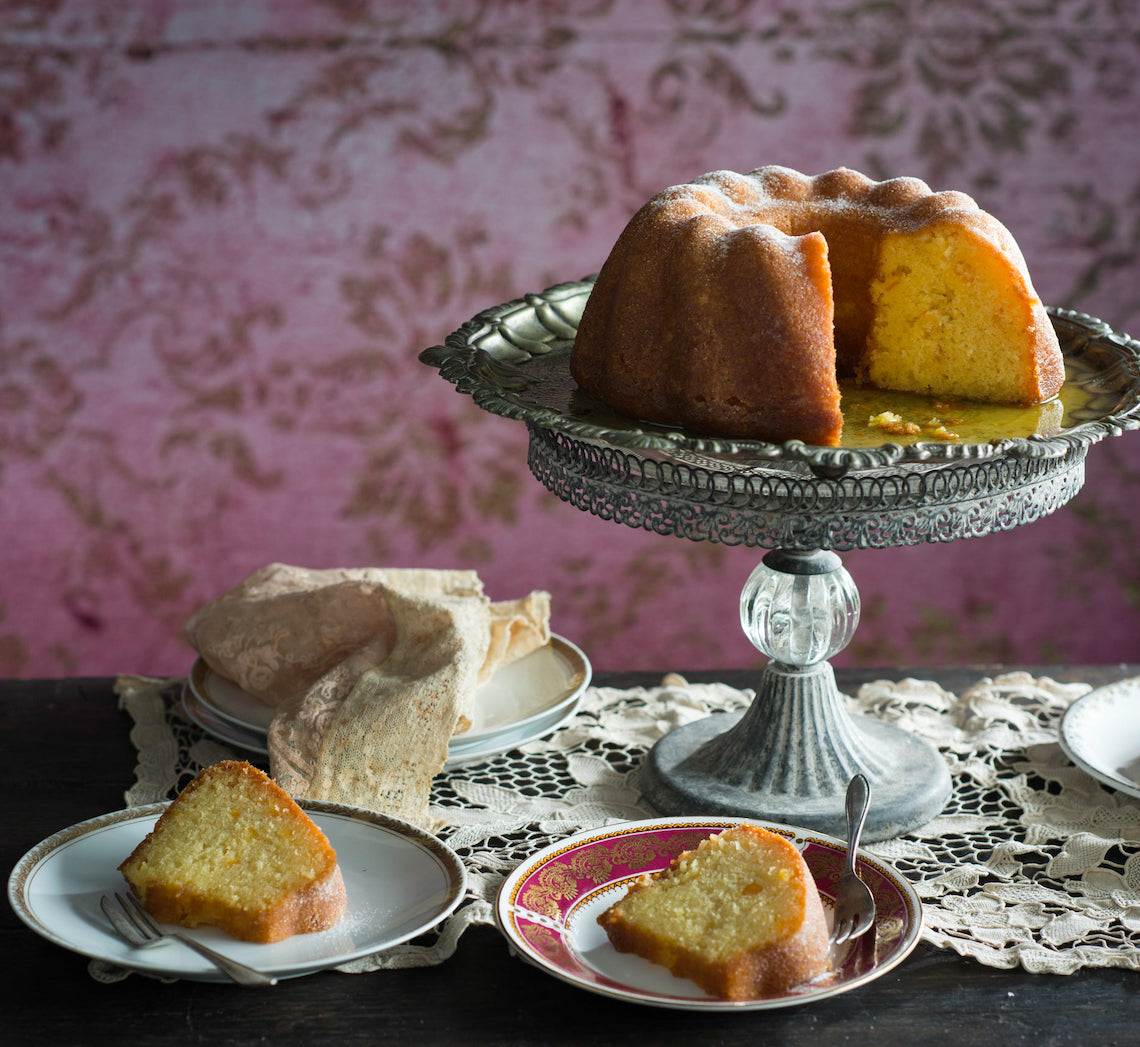
Prep 30minBake 50minMakes 12 serves
Originally a cake of the poor, Gugelhupf is a firm staple in Austria and is of the most popular afternoon tea offerings especially in the local kafes (coffee houses). But, as Emperor Franz Josef preferred, it is often eaten for breakfast. There seem to be as many variations of this yeast or sponge-based cake as there are days in the year – this one has a luscious orange syrup to keep it lovely and moist.
Ingredients
20g (¾oz) butter, melted, combined with 1½ teaspoons plain flour, to grease
250g (9oz) unsalted butter, at room temperature
125g (1 cup/4½oz) icing sugar, sifted
2 teaspoons natural vanilla essence or extract
4 eggs, at room temperature, separated
250g (1⅔ cups/9oz) plain flour, plus extra to dust
1½ teaspoons baking powder
Good pinch of salt
75g (2¾oz) candied orange rind
110g (½ cup/4oz) caster sugar, plus 1 tablespoon extra to sprinkle
Orange Syrup
250ml (1 cup/9fl oz) strained fresh orange juice
145g (⅔ cup/5oz) caster sugar
50ml (2½ tablespoons/1¾fl oz) orange liqueur
Method
- Preheat oven to 180°C/350°F (160°C/315°F fan-forced). Brush a 2.5 litre/5.25pt (24cm/ 9½in diameter) bundt tin with the melted butter and flour mixture to grease.
- Use an electric mixer to beat the butter and icing sugar and vanilla until pale and creamy. Add the egg yolks and beat until well combined and creamy.
- Sift together the flour, baking powder and salt and then stir through the candied rind. Use an electric mixer with a whisk attachment to whisk the egg whites with the salt until soft peaks form. Add the caster sugar and whisk until thick and glossy. Use a large metal spoon or spatula to fold the egg whites into the butter mixture until evenly combined. Then gently fold in the flour mixture until just combined.
- Spoon the mixture into the prepared tin and smooth the surface with the back of a spoon. Bake in preheated oven for 45-50 minutes or until a skewer inserted comes out clean. Stand in the tin for 5 minutes before turning onto a plate with a lip.
- Meanwhile, to make the Orange Syrup, combine the orange juice and sugar in a small saucepan and stir over medium heat until the sugar dissolves. Bring to a simmer and then remove from the heat. Stir in the orange liqueur.
- Slowly pour the hot syrup over the hot cake, allowing it to soak in as much as possible. Sprinkle with the extra caster sugar and cool to room temperature (this will take about 1 hour). Serve in slices for morning or afternoon tea or dessert on its own or with cream.
Baker's Tips
- This cake will keep in an airtight container at room temperature for up to 3 days.
This recipe is from Anneka's SBS Food online column, Bakeproof: Austrian Baking.
CLICK HERE for more Bakeproof recipes.
Photography by Alan Benson.
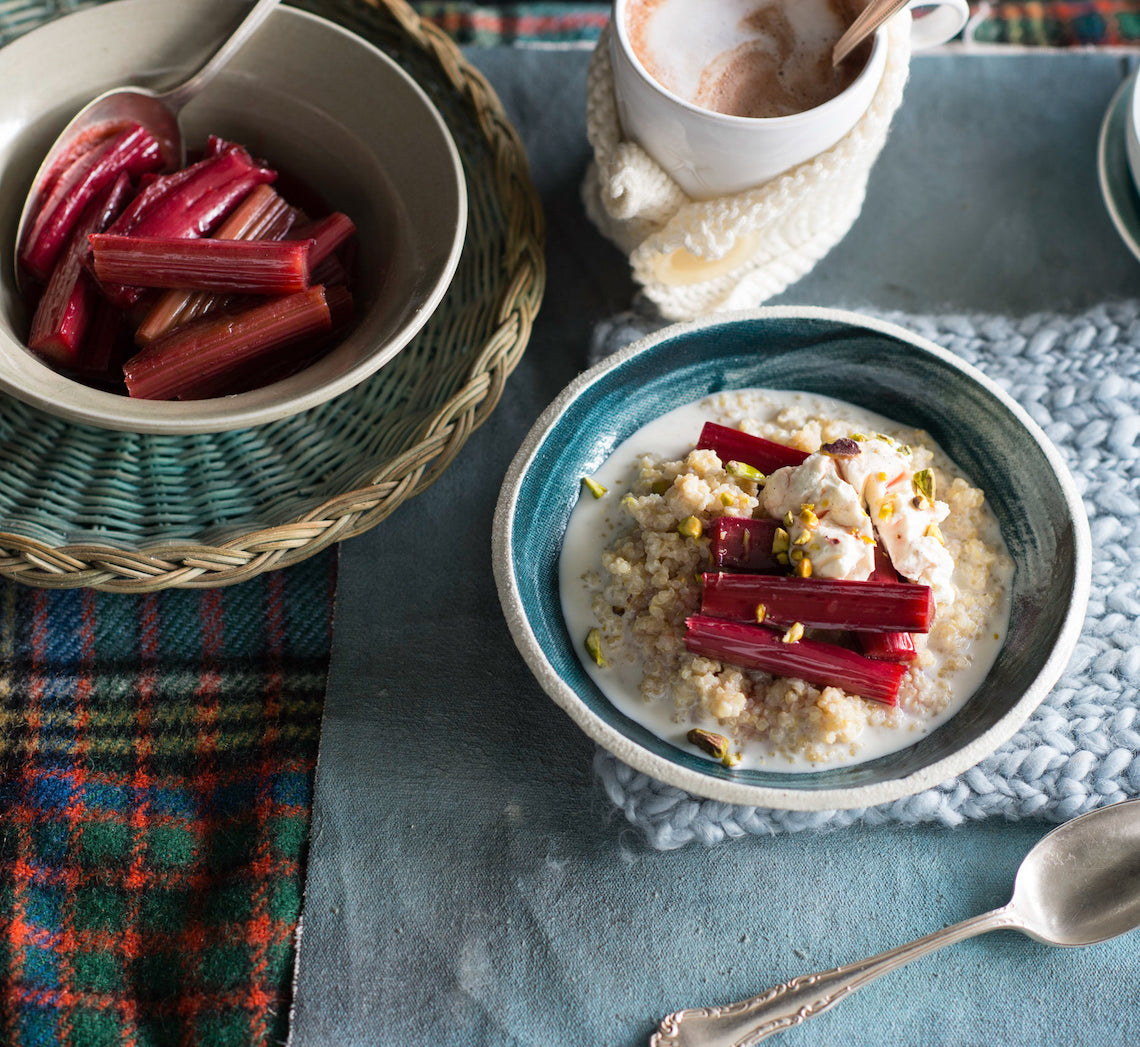
Prep 25min (+overnight standing time)Bake 55minMakes 6-8 serves
Quinoa porridge is currently the darling of the café menu. This one is a no-fuss baked version teamed with tangy rhubarb and a vanilla and honey-spiked labna, so you can enjoy this beauty without even leaving home.
Ingredients
300g (1½ cups) white quinoa
500ml (2 cups) boiling water
55g (¼ cup, firmly packed) brown sugar
1 cinnamon stick
375ml (1½ cups) milk
Toasted pistachio kernels, chopped, to serve
Vanilla-honey labna
1½ vanilla beans, split and seeds scraped
390g (1½ cup) greek-style natural yoghurt
¼ cup honey
Roasted rhubarb
550g trimmed rhubarb (about 2 bunches), cut into 6cm lengths
110g (½ cup) raw sugar
Method
- To make the Vanilla labna, place the vanilla seeds (reserve the bean for the rhubarb), yoghurt and honey in a bowl and stir to combine evenly. Line a sieve with two layers of muslin cloth or a linen tea towel and place over a bowl. Spoon the yoghurt into the sieve, fold any overhanging cloth over to enclose the yoghurt. Refrigerate overnight (at least 8 hours) to drain.
- Preheat oven to 200ºC (180ºC fan-forced). To make the Oven-baked quinoa, combine the quinoa, boiling water, brown sugar and cinnamon in a 1.5 litre capacity (6 cup) ovenproof dish. Cover with foil and bake for 30 minutes, stirring occasionally.
- Meanwhile, to make the Roasted rhubarb, rinse the rhubarb and shake off any excess water. Place in a bowl with the sugar and reserved vanilla bean and toss to combine. Transfer to an ovenproof dish just large enough to hold the rhubarb in a single layer and cover with foil.
- After the quinoa has been baking for 30 minutes, stir in the milk, cover and return to the oven with the rhubarb. Bake for another 20 minutes, stirring the quinoa 2-3 more times during baking.
- Remove the foil from the rhubarb and bake both for a further 5 minutes or until the quinoa is tender and porridge-like and the rhubarb is still holding its shape but tender when tested with a skewer.
- Immediately spoon the quinoa porridge into bowls, top with the rhubarb and pan juices, and a spoonful of labna. Sprinkle with pistachios and serve immediately.
Baker's Tips
- The rhubarb can be roasted up to 2 days before serving and kept in an airtight container in the fridge. Remove from the fridge about 1 hour before serving to bring to room temperature
- The vanilla and honey labna can be made up to 3 days before serving. Keep in an airtight container in the fridge.
This recipe is from Anneka's SBS Food online column, Bakeproof: Autumn Brunch
CLICK HERE for more Bakeproof recipes.
Photography by Alan Benson.
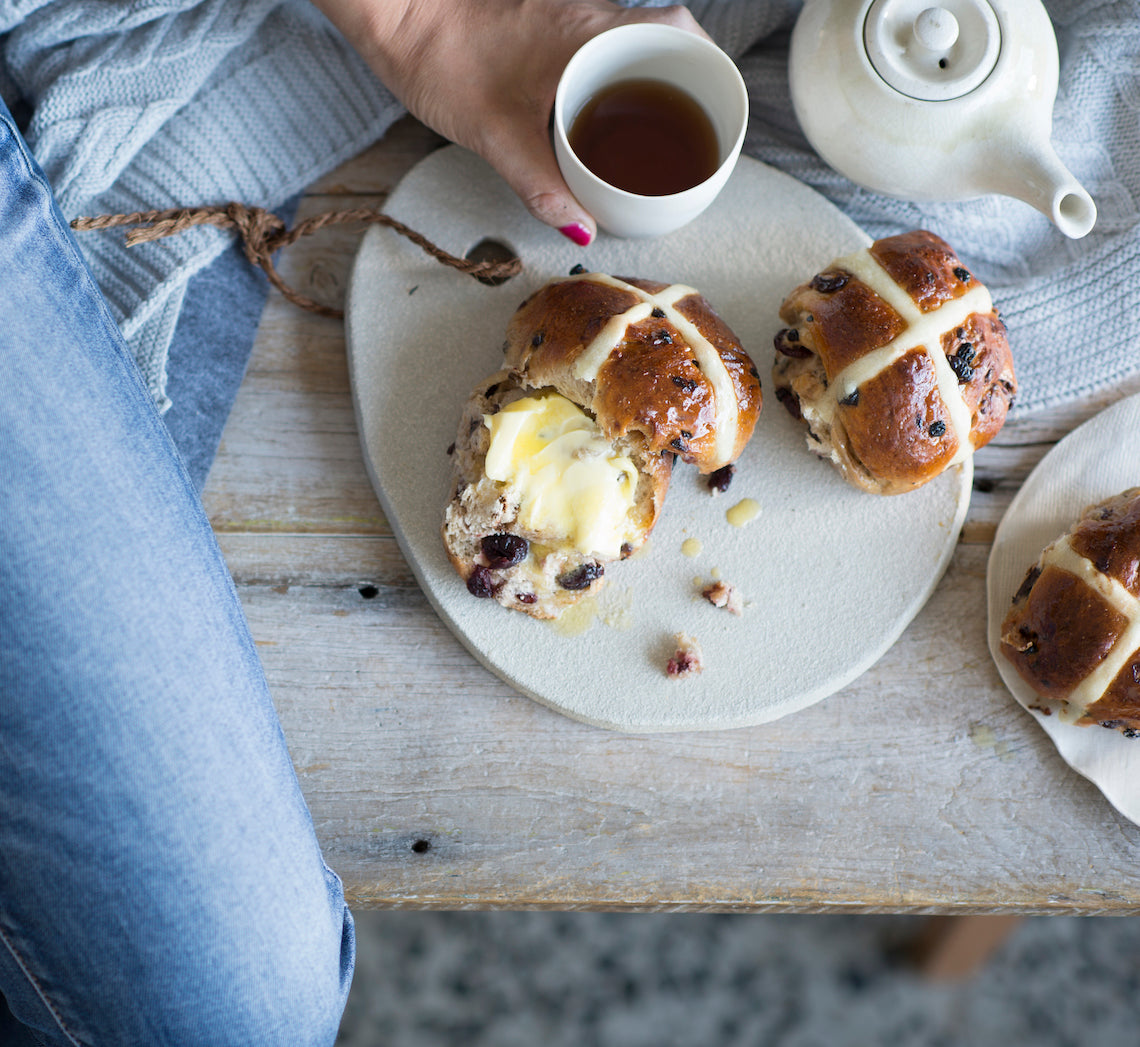
Prep 25min (+1hr 30min proving time)Bake 25minMakes 12
An updated version of the traditional favourite, these hot cross buns are studded with chunks of dark chocolate and tart, dried cherries. They're simply too hard to resist – especially when served warm with lashings of butter!
Ingredients
750g (5 cups/1lb 10½oz) strong bread or pizza (high protein) flour (see Baker's Tips)
55g (¼ cup/2oz) caster sugar
2 x 7g sachets (4 teaspoons) instant dried yeast
1½ teaspoons mixed spice
1½ teaspoons ground cinnamon
1 teaspoon salt
150g (1 cup/5¼oz) dried cherries (see Baker's Tips)
75g (½ cup/2¾oz) currants
435ml (1¾ cups/14¾fl oz) milk
60g (2fl oz) salted butter, cubed, plus extra, to grease and serve
2 eggs, at room temperature
1 teaspoon natural vanilla essence or extract
100g (3½oz) good-quality dark chocolate, chopped
Flour paste
75g (½ cup/2¾oz) plain flour
75ml (2½fl oz) water
Glaze
55g (¼ cup/ 2oz) caster sugar
2 tablespoons water
Method
- Put the bread flour, sugar, yeast, mixed spice, cinnamon and salt in a large bowl and mix to combine. Stir through the dried cherries and currants.
- Heat the milk and butter in a small saucepan over medium heat until the butter has just melted and the milk is lukewarm. Whisk one of the eggs with the vanilla and add to the milk mixture. Whisk to combine. Add to the dry ingredients and use a wooden spoon and then your hands to mix to a soft dough.
- Turn out onto a lightly floured bench top. Knead for 8-10 minutes or until smooth and elastic. Lightly grease a clean large bowl with a little butter, add the dough and turn to coat the dough. Cover with plastic wrap and set aside in a warm, draught-free place for 1 hour or until doubled in volumn.
- Line a large baking tray with baking paper. Punch the centre of the dough down with your fist. Turn onto a lightly floured bench top. Knead for 2-3 minutes or until smooth. Knead in the chocolate until evenly combined. Divide the dough into 12 equal portions. Roll each portion into a ball and place on the tray, allowing a little room for spreading. Cover with a damp tea towel and set aside in a warm, draught-free place for 30 minutes or until almost doubled in size.
- Preheat the oven to 180°C/350°F (160°C/315°F fan-forced). Meanwhile, make the Flour Paste. Combine the flour and water in a bowl and beat with a wooden spoon until smooth. Spoon into a small, good-quality snap-lock bag and seal.
- Whisk the remaining egg and brush the tops of the buns with it. Snip a small hole in the corner of the snap-lock bag containing the Flour Paste and pipe crosses on the buns.
- Bake in the preheated oven for 25 minutes or until the buns are cooked and sound hollow when tapped on the base.
- Meanwhile, make the Glaze. Combine the sugar and water in a small saucepan over medium heat and stir until the sugar dissolves. Bring to a simmer and simmer for 1 minute. Transfer the hot cross buns to a wire rack and brush the tops with the glaze. Serve warm, spread with butter.
Baker's Tips
- Bread and pizza flour (also known as 'strong' flour) has a higher gluten content than regular plain flour. This type of flour is more suited to use in yeast-based bread recipes like these buns and will give you a better final texture (the resulting bread will be more 'bread-like' with a slightly chewy texture rather than a fine, cake-like texture). Look for a protein content of around 11-13 percent for the best results with this recipe.
- Dried cherries are available at selected supermarkets, delicatessens, grocery shops and specialty food stores. You can replace them with good-quality dried cranberries.
- These hot cross buns are best eaten the day they are made although they will freeze well. To freeze, wrap in plastic wrap and then seal in an airtight container or freezer bag and freeze for up to 3 months. Thaw them at room temperature or split while still frozen and toast.
Recipe from BakeClass by Anneka Manning (Murdoch Books).
Photography by Alan Benson.
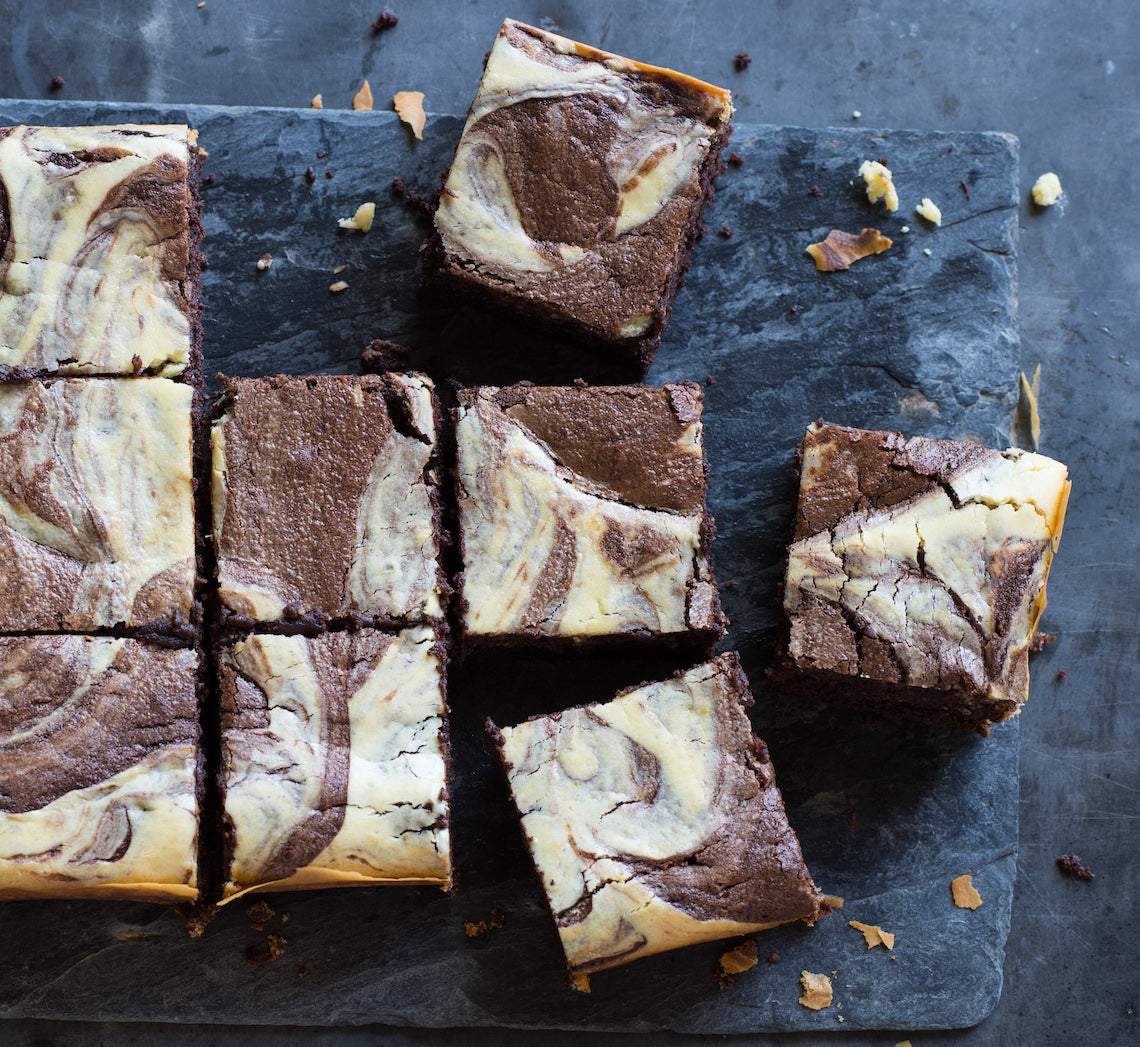
Prep 25min (+ 1hr cooling time)Bake 45-50minMakes about 15
Essentially these fudgy brownies are marbled with an orange-scented cheesecake and they appear far more difficult to make than what they actually are. Perfect with a cuppa or a dollop of cream for dessert these brownies will satisfy any chocolate craving.
Ingredients
Brownie base
Melted butter, to grease250g good-quality dark chocolate (45-54% cocoa), chopped
150g salted butter, cubed
165g (¾ cup) caster sugar
3 eggs, at room temperature, lightly whisked
75g (½ cup) plain flour
30g (¼ cup) cocoa powder
¾ teaspoon baking powder
Cheesecake topping
200g cream cheese, at room temperature30g salted butter, at room temperature
1 tablespoon finely grated orange zest
55g (¼ cup) caster sugar
1 egg yolk, at room temperature
Method
- Preheat oven to 160ºC (140ºC fan-forced). Grease a 16cm x 26cm shallow slice tin with melted butter and line the base and long sides with one piece of baking paper.
- To make the Cheesecake Topping, use an electric mixer to beat the cream cheese, butter and orange rind in a medium bowl until creamy and smooth, scraping down the sides of the bowl when necessary. Add the sugar and beat until well combined. Add the egg yolk and beat well. Set aside.
- To make the Brownie Base, place the dark chocolate and butter in a medium heatproof bowl over a saucepan of gently simmering water (don’t let the base of the bowl touch the water). Stir occasionally until chocolate and butter melt and the mixture is smooth. Remove bowl from saucepan. Add the sugar and eggs and use a balloon whisk or wooden spoon to stir until well combined. Sift together the flour, cocoa powder and baking powder. Add to chocolate mixture and stir until just combined.
- Spoon half the Brownie Base mixture into prepared tin and spread evenly. Drop spoonfuls of almost all the Cheesecake Topping randomly over the brownie mixture. Top with spoonfuls of the remaining brownie mixture and then the remaining topping mixture. Tap the tin on the benchtop to settle the mixture. Use a butter knife or palette knife to swirl the two mixtures together to create a marbled effect and then tap on the bench again if necessary.
- Bake in preheated oven for 45-50 minutes or until moist crumbs cling to a skewer inserted in the centre. Remove from the oven and cool in tin on a wire rack (this will take about 1 hour).
- Carefully remove brownie from the tin using the baking paper to lift it out. Cut into portions to serve.
Baker's Tips
- These brownies will keep in an airtight container in the fridge, for up to 5 days. Serve at room temperature.
This recipe is from Anneka's SBS Food online column, Bakeproof: Easy Chocolate Cakes. CLICK HERE for more Bakeproof recipes.
Photography by Alan Benson.
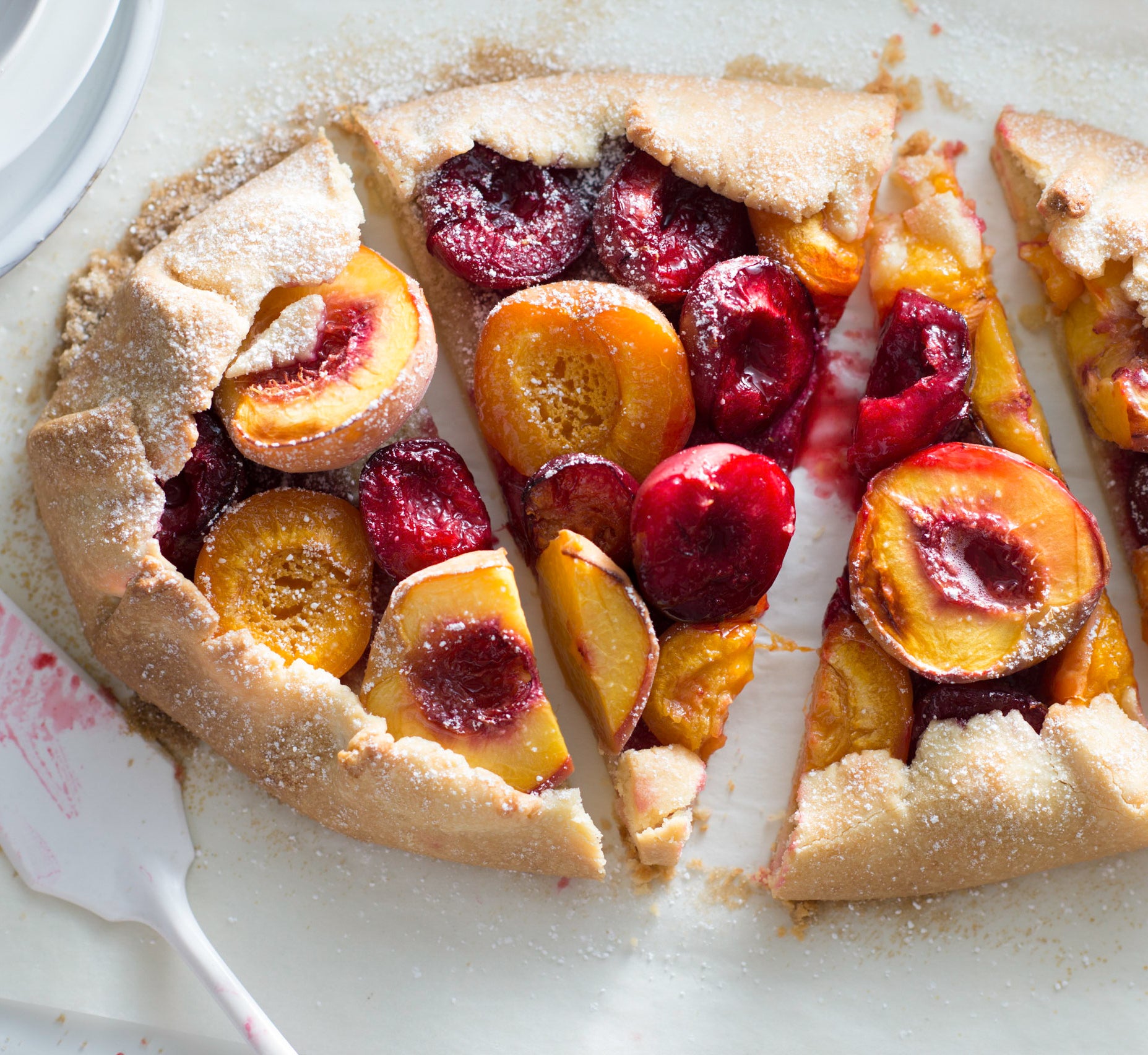
Prep 25min(+ pastry making and chilling time)Bake 50-55minMakes 8-10 serves
This tart is simplicity at its best – a selection of gorgeous summer stone fruit encased in a sweet, easy-peasy pastry. There's no real structure, it's slightly rustic and lets seasonal stone fruits shine. Serve with toffee ice-cream if you can – the combination is sublime.
Ingredients
1 quantity of Sweet Shortcrust Pastry (see Variations)
25g (¼ cup/¾oz) almond meal
700g (1lb 8oz) firm but ripe stone fruit of your choice (such as peaches, nectarines, plums and apricots), halved and pitted
2 tablespoons raw sugar
Icing sugar, to dust (optional)
Good-quality toffee or vanilla ice-cream, to serve
Method
- Preheat oven to 200°C/400°F (180°C/350°F fan-forced).
- Use a lightly floured rolling pin to roll out the pastry on a piece of non-stick baking paper to a rough rectangle about 3mm/⅛in thick. Use the paper to transfer the pastry to a large baking tray. Sprinkle the pastry with the almond meal, leaving a 5cm/2in-wide border around the edge. Arrange the fruit over the almond meal and then fold the pastry border up over the fruit. Sprinkle the upturned border and fruit with the sugar. Bake in preheated oven for 50-55 minutes or until the pastry is golden and crisp.
- Serve warm or at room temperature, dusted with icing sugar, if desired, cut into wedges and accompanied by ice-cream.
Baker's Tip
- This tart is best served warm, but is also great served at room temperature. It will keep covered in the fridge for up to 2 days. Stand at room temperature for about 30 minutes before serving.
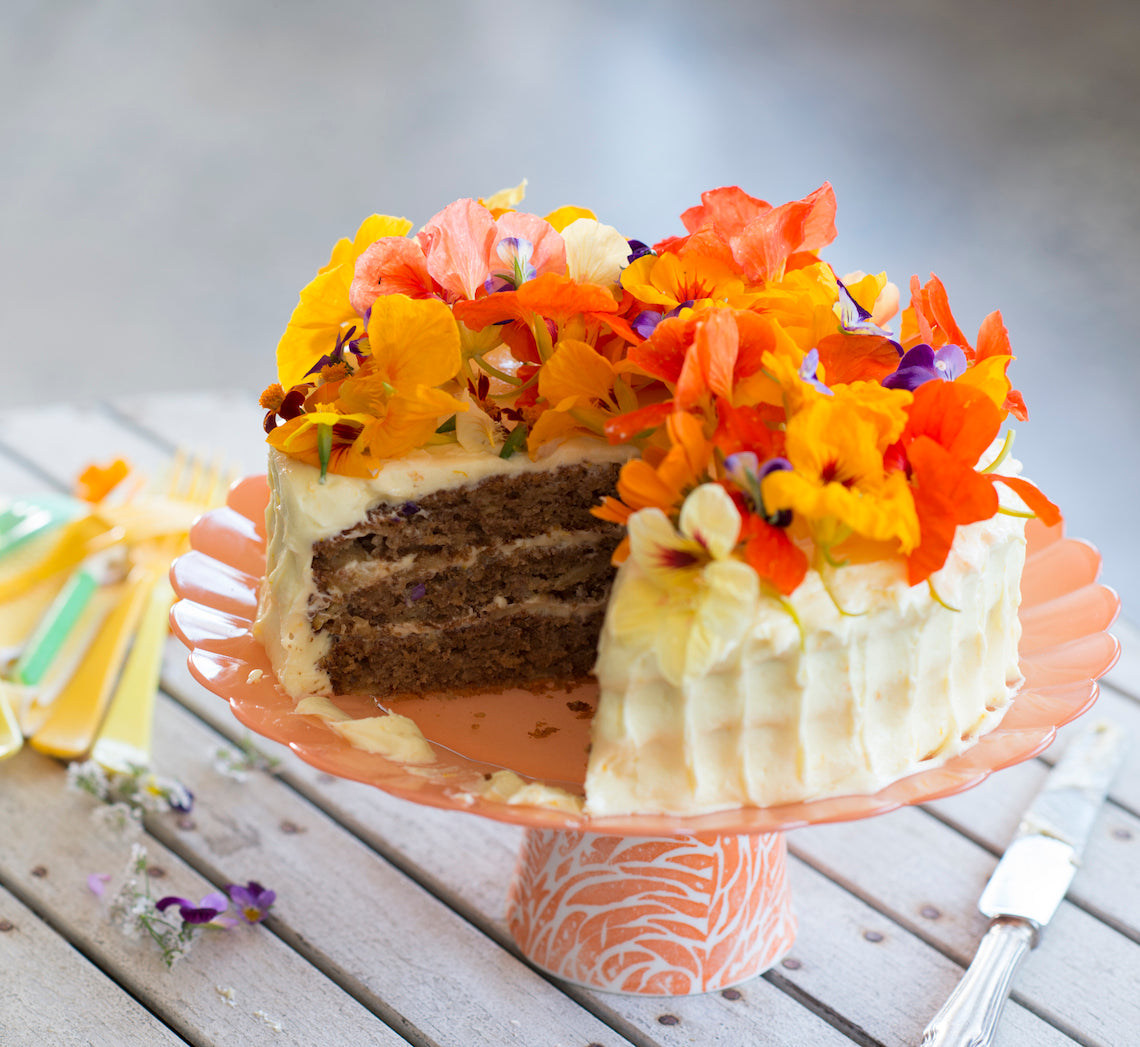
Prep 30minBake 30-35minMakes 12-15 serves
Originating (and excessively popular) in America, Hummingbird cake is a tropical mix of banana and pineapple, and when layered with an orange cream cheese frosting makes a great celebration cake. Sweet and indulgent, a small slice is all that is needed to satisfy.
Ingredients
150g (1 cup) plain flour
75g (½ cup) self-raising flour
½ teaspoon bicarbonate of soda
2 teaspoons ground cinnamon
220g (1 cup, firmly packed) brown sugar
45g (½ cup) desiccated coconut
2 very ripe large bananas (about 250g each)
440g crushed pineapple in natural juice, drained and juice reserved
2 eggs, lightly whisked
185ml (¾ cup) sunflower oil, plus extra to grease
Orange cream cheese frosting
100g unsalted butter, at room temperature
250g cream cheese, at room temperature
1 orange, zest finely grated
375g (3 cups) icing sugar mixture, sifted
Method
- Preheat oven to 180°C (160°C fan-forced). Brush three 20cm round cake tins with extra sunflower oil to lightly grease and line the bases with non-stick baking paper.
- Sift together the plain and self-raising flours, bicarbonate of soda and cinnamon. Add the brown sugar and coconut and stir to combine, breaking up any lumps.
- Mash the banana and combine with the drained pineapple, 80 ml (⅓ cup) of the reserved pineapple syrup, eggs and oil. Add to the flour mixture and use a wooden spoon or spatula to mix until just combined.
- Divide the mixture evenly among the prepared tins and spread with the back of a metal spoon to smooth the surface. Bake in preheated oven for 30-35 minutes or until cooked when tested with a skewer.
- Stand the cakes in the tins for 5 minutes before turning onto wire racks to cool (this will take about 1 hour).
- Meanwhile, to make the Orange cream cheese frosting, use an electric mixer to beat the cream cheese, butter and orange zest until very smooth. Gradually add the icing sugar, beating well after each addition and beat until well combined and really creamy. Divide the Orange cream cheese frosting evenly among 3 bowls.
- Take one portion of the Orange cream cheese frosting and use a palette knife to spread half over one cake layer. Top with a second cake layer and spread with the remaining frosting of the first portion. Top with the remaining cake layer. Spread another portion of frosting over the sides and the remaining portion over the top of the cake. Sprinkle with the pecans to decorate
Baker's Tips
- This cake will keep in an airtight container in the fridge for up to 4 days. Stand at room temperature for about 30 minutes before serving.
This recipe is from Anneka's SBS Food online column, Bakeproof: Cakes for Crowds. CLICK HERE for more Bakeproof recipes.
Photography by Alan Benson.
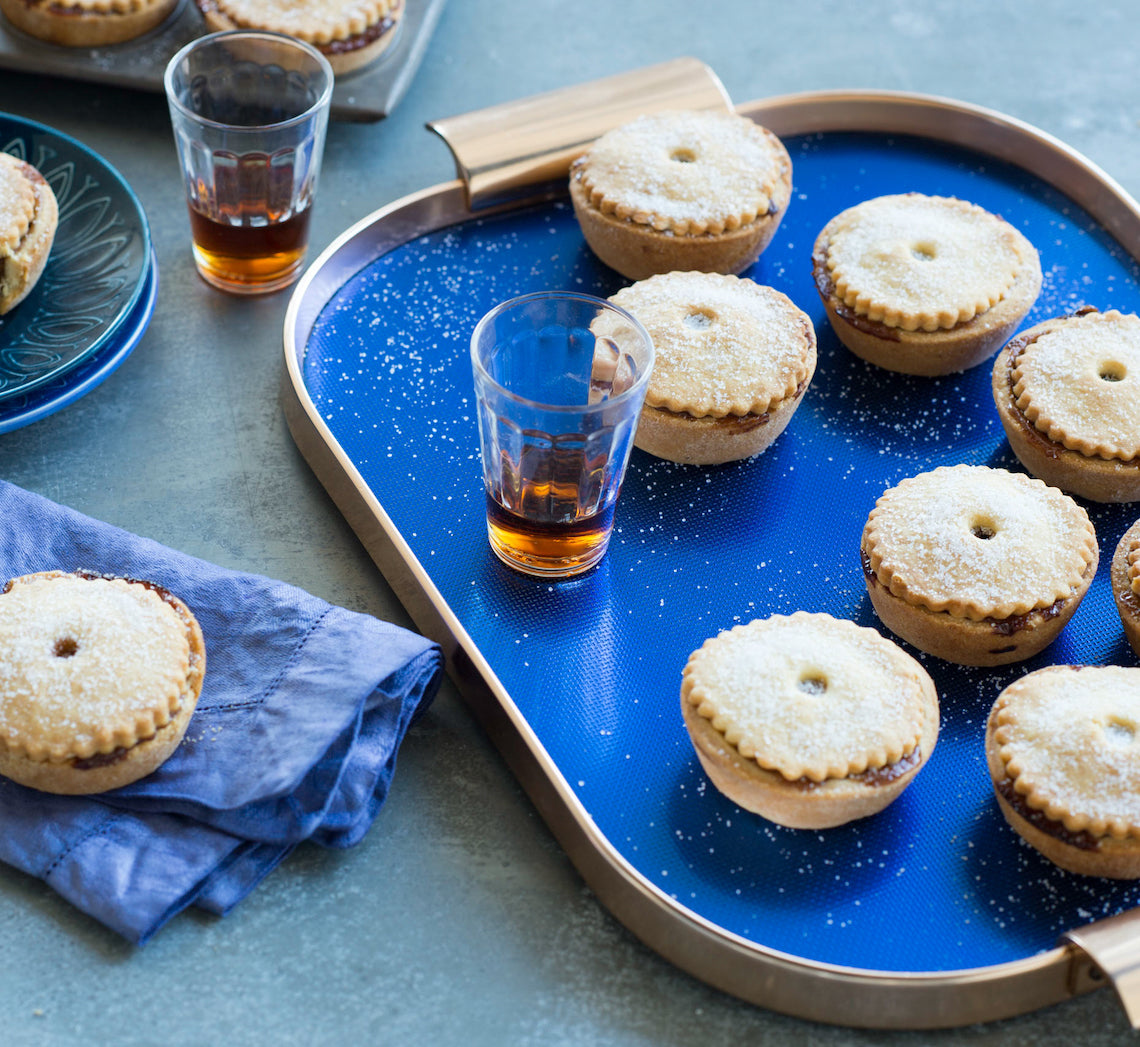
Prep 50min (+20min chilling and 50min cooling time)Bake 35minMakes about 20
According to a Middle Ages custom, if you eat a mince pie every day from Christmas day until Twelfth Night (6 January) you will have happiness for the whole year – what a wonderful excuse to indulge in these spiced, fruit-filled pies. Eat them at room temperature or straight from the oven with ice-cream, cream or brandy sauce.
You will need two 12-hole 80 ml (⅓ cup) muffin tins for this recipe.
Ingredients
Granulated sugar, to sprinkle
Fruit mince
2 small (about 150g each) Granny Smith apples, peeled, cored and coarsely grated
130 g (¾ cup) sultanas
115g (¾ cup) currants
130g (¾ cup) seedless raisins
75g (½ cup) mixed peel or chopped glace apricots
50g (⅓ cup) chopped blanched almonds
125ml (½ cup) brandy or apple cider
1 orange, zest finely grated and juiced
1 lemon, zest finely grated and juiced
2 teaspoons mixed spice
½ teaspoon ground ginger
¼ teaspoon ground cloves
100g (½ cup, loosely packed) dark brown sugar
60g unsalted butter, coarsely grated
Sweet shortcrust pastry
600g (4 cups) plain flour
125g (1 cup) icing sugar, sifted
1 teaspoon baking powder
½ teaspoon salt
300g chilled unsalted butter, diced
2 egg yolks
80-100ml iced water
Method
- To make the fruit mince, combine the grated apple, dried fruit, mixed peel, almonds, brandy or cider, orange and lemon zest and juice, and the spices in a medium saucepan. Cook over low heat, stirring occasionally for 20 minutes or until the excess liquid has evaporated. Remove from heat and set aside for 40 minutes or until cooled to room temperature.
- Meanwhile, to make the pastry, place the flour, icing sugar, baking powder and salt in a medium mixing bowl. Add the chilled butter. With your palms facing upwards, use your fingertips to rub in the butter until the mixture resembles coarse breadcrumbs. Use a fork to whisk together the egg yolks and 80 ml (⅓ cup) of the iced water and then sprinkle over the flour and butter mixture. Use a round-bladed knife in a cutting motion to mix until evenly combined and the mixture starts holding together. Press a little of the mixture between your fingers: if it holds together easily, there is no need to add more water. If it doesn’t, add the remaining 1 tbsp (20 ml) water and combine. The pastry should be soft but not sticky. Bring the pastry together with your hands and transfer to a lightly floured, cool bench top. Lightly knead the pastry with your fingertips for about 30 seconds or until smooth and soft. Divide pastry into three portions. Shape each into a disc, wrap separately in plastic wrap and place in the fridge for 20 minutes to rest.
- Preheat oven to 190°C (170°C fan-forced). Stir the sugar and butter through the cooled fruit mince.
- Use a lightly floured rolling pin to roll out one portion of the pastry to 3 mm thick. Use a 9 cm plain round cutter to cut out 10 rounds, re-rolling the offcuts if needed and line 10 x 80ml (⅓ cup) muffin tin holes, pressing into the sides and base with your fingertips (the pastry won’t reach to the top of the holes). Repeat with another portion of pastry to make another 10 pastry shells. Divide the fruit mince evenly among the pastry shells. Roll out the remaining pastry portion until 5 mm thick and use a 6.5 cm fluted round cutter to make the pie tops, re-rolling the off-cuts if needed. Use the end of a 7 mm piping nozzle to cut out a circle in the centre of each lid. Place a lid on top of each pie, and use your fingertips to gently ease the pastry out to meet the pastry case bases. Sprinkle each pie with a little granulated sugar.
- Bake in preheated oven for 35 minutes or until the pastry is deep golden and cooked through. Remove from the oven and stand in the tin for 10 minutes to cool slightly before transferring to a wire rack. Serve warm or at room temperature. Sprinkle with a little more granulated sugar, if desired.
Baker's Tips
- These pies will keep in an airtight container at room temperature for up to 1 week.
- To reheat, place the pies back in the muffin holes and place in an oven preheated to 170°C (150°C fan-forced) for 10-15 minutes or until heated through.
This recipe is from Anneka's SBS Food online column, Bakeproof: Traditional Christmas Baking. CLICK HERE for more Bakeproof recipes.
Photography by Alan Benson.

Prep 40min (+ 30min cooling time)Bake 25-30minMakes about 24
Originating in Vienna in Austria these vanilla sugar-coated biscuits are always made in a ‘kipfler’ or horse-shoe shape. Traditionally made at Christmas, they’re also popular in many other eastern European countries, including Germany, Hungary, Slovakia, Romania and the Czech Republic. These buttery almond biscuits make a wonderful gift.
Ingredients
185g unsalted butter
60g (½ cup) icing sugar mixture, plus 60g (½ cup) extra to coat
1 teaspoon natural vanilla essence or extract
2 egg yolks
225g (1½ cups) plain flour
50g (½ cup) almond meal
1 vanilla bean
Method
- Preheat oven to 160°C. Line two large oven trays with non-stick baking paper.
- Use an electric mixer to beat the butter, icing sugar mixture and vanilla essence or extract until pale and creamy. Add the egg yolks and beat until well combined.
- Combine the flour and almond meal, add to the butter mixture and beat on lowest possible speed until just combined.
- Shape level tablespoonfuls of the mixture into small logs about 6cm long and then taper the ends and shape into a crescent shape. Place on the lined trays about 2cm apart. Bake in preheated oven for 25-30 minutes or until pale golden and cooked through.
- Meanwhile, halve the vanilla bean lengthways, use a small sharp knife to scrape the seeds out and add to the extra icing sugar mixture in a medium bowl. Use your fingertips to rub the vanilla seeds through the icing sugar evenly.
- When the biscuits are cooked, remove from the oven and then toss while still warm, one at a time, through the vanilla icing sugar to coat (see Baker’s tips). Cool completely on a wire rack.
Baker's Tips
- These biscuits will keep in an airtight container at room temperature for up to 1 week.
- Reserve any remaining vanilla sugar and use to sprinkle over the biscuits before serving if you wish.
This recipe is from Anneka's SBS Food online column, Bakeproof: Traditional Christmas Baking.
CLICK HERE for more Bakeproof recipes.
Photography by Alan Benson.
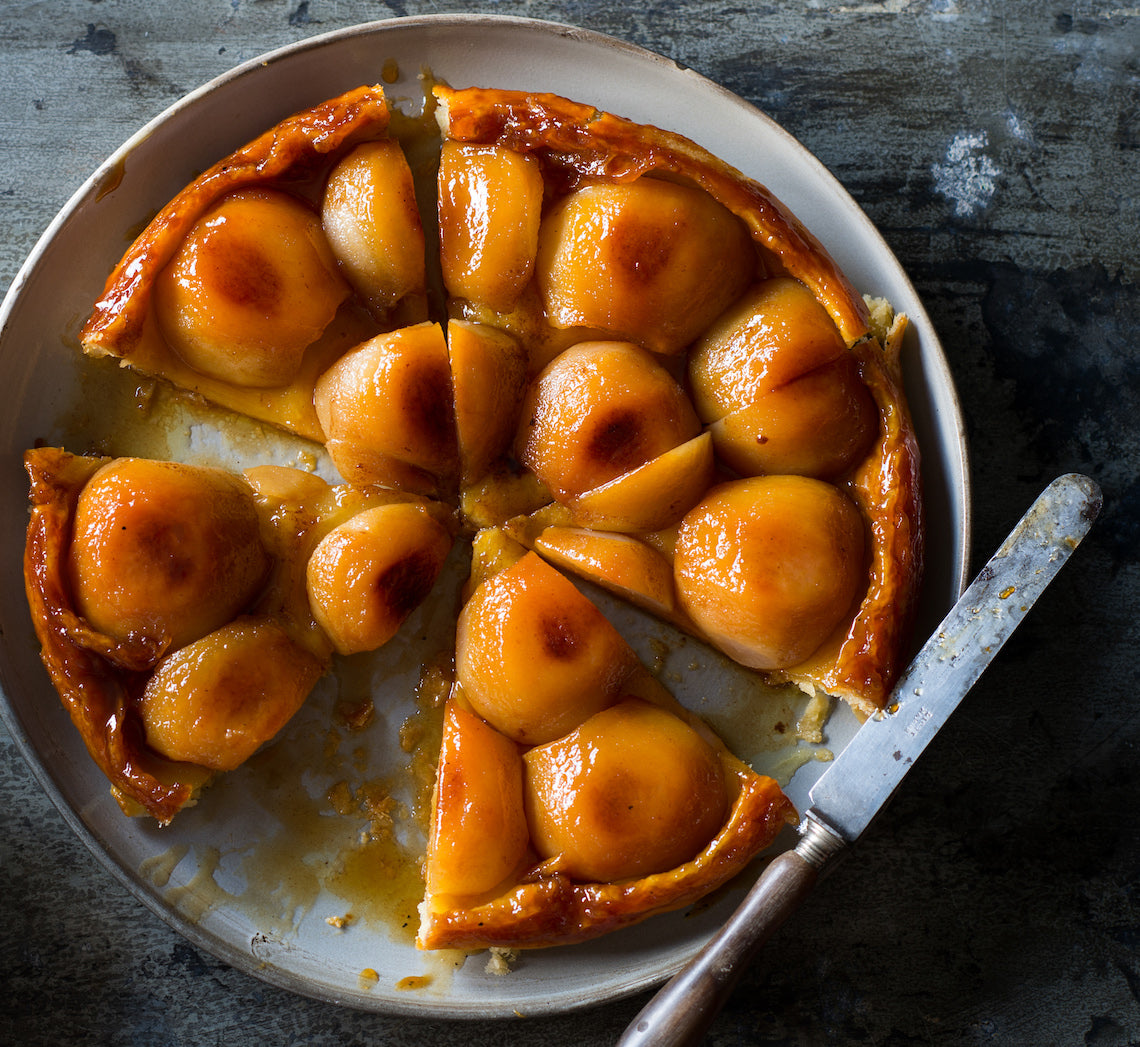
Prep 40min (+20min chilling and 1hr 25min cooling time)Bake 45minMakes 8 serves
Traditionally made with apples, this classic upside-down French tart was created by the Tatin sisters who ran a hotel in France in the early 1900s. If you don't have an ovenproof frying pan, transfer the cooled caramel and pears to a base-lined 22cm round cake tin before covering them with the pastry and baking.
Ingredients
Ground cinnamon, to sprinkle
Vanilla ice-cream, cream or crème fraiche, to serve
1 quantity Shortcrust Pastry
80g (2¾oz) salted butter, cubed
110g (½ cup/4oz) caster sugar
1.1kg (2lb 7oz) small (about 7) pears (such as Josephine), peeled, halved and cored
Method
- Prepare the Shortcrust Pastry.
- Meanwhile, melt the butter in a 20–22cm/8-8¼in(base measurement) heavy-based frypan over medium-high heat. Sprinkle with the sugar and then arrange the pears, cut-side up, in the pan, cutting some of the halves into quarters to fill the gaps. Reduce the heat to medium and cook, uncovered, for 15 minutes or until the liquid becomes a dark caramel and the pears are almost tender and golden underneath. Remove the pan from the heat and set aside for 1 hour 15 minutes or until cooled completely.
- Preheat oven to 190°C/375°F (170°C/340°F fan-forced).
- Use a lightly floured rolling pin to roll the pastry out on a lightly floured bench top to about 5mm/¼in thick and then cut into a circle about 26cm/10½in in diameter. Place the pastry over the cooled pears in the pan and carefully tuck the pastry edge around the fruit and down the side of the pan. Bake in preheated oven for 45 minutes or until the pastry is deep golden and cooked through and the pear juices are bubbling. Remove from the oven and set aside for 10 minutes to cool slightly.
- Place a serving plate with a lip over the top of the tart and invert. Serve immediately cut into wedges and accompanied by ice-cream, cream or crème fraiche.
This recipe is from Anneka's SBS Food online column, The real secrets of French baking.
CLICK HERE for more Bakeproof recipes.
Photography by Alan Benson.
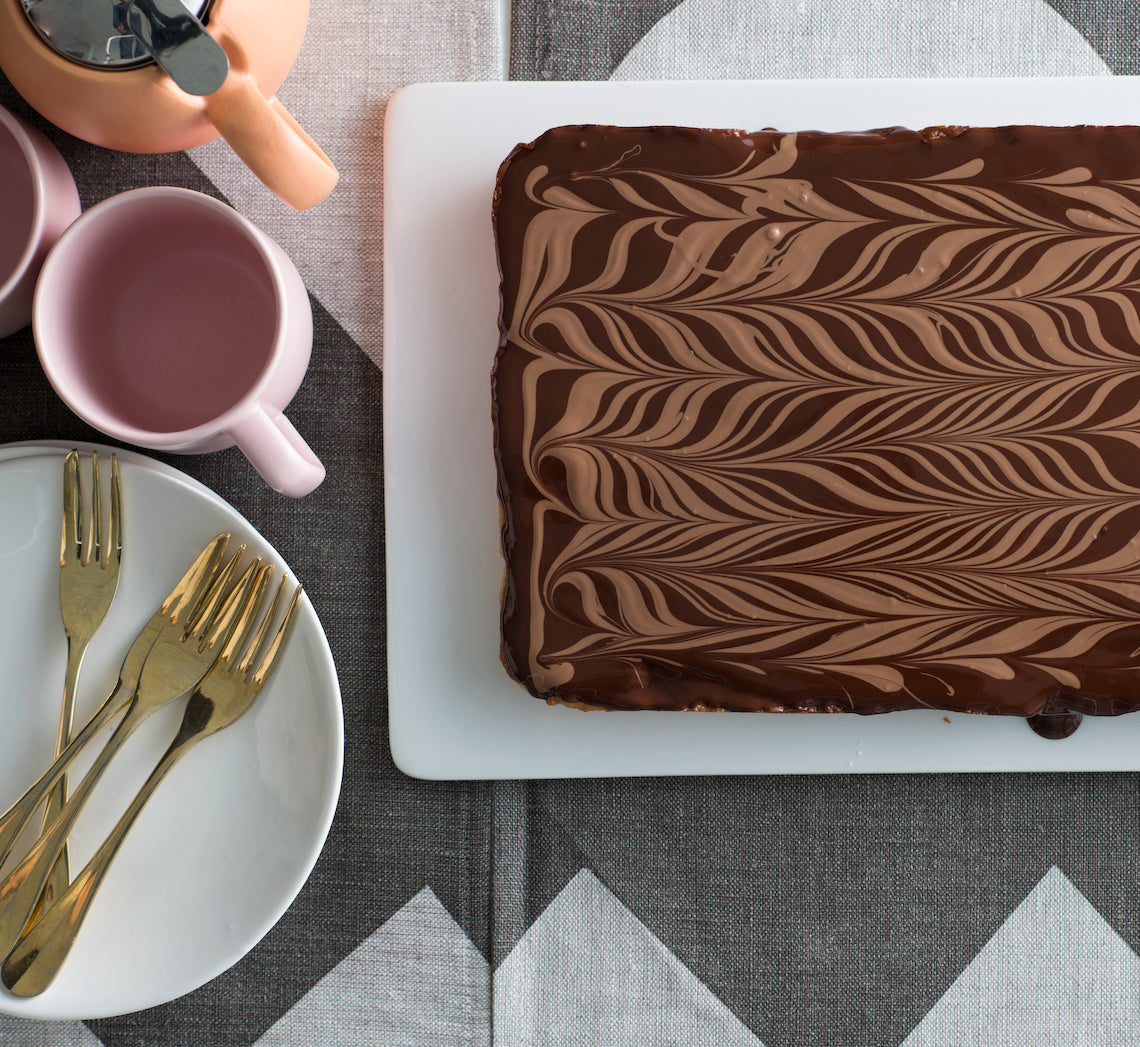
Prep 30min (+1hr cooling and 1hr chilling time)Bake 20minMakes 20 pieces
This has to be the perennial favourite... biscuit base, gooey caramel centre and chocolate topping is a combination made in heaven. This chocolate caramel slice has been given a little makeover with a feather-patterned topping.
Ingredients
110g (¾ cup/4oz) plain flour
½ teaspoon baking powder
30g (⅓ cup/1oz) desiccated coconut
75g (⅓ cup, firmly packed/2¾oz) brown sugar
80g (2¾oz) salted butter, melted
1 teaspoon natural vanilla essence or extract
Caramel filling
395g (13¼oz) tin sweetened condensed milk
110g (½ cup, firmly packed/4oz) brown sugar
1 tablespoon golden syrup
40g (1½oz) salted butter, cubed
Chocolate topping
200g (7oz) good-quality dark chocolate (70% cocoa), chopped
30g (1oz) salted butter, cubed
75g (2¾oz) good-quality milk chocolate
Method
- Preheat oven to 180°C/350°F (160°C/315°F fan-forced). Grease a 16cm x 26cm (6 ¼in x 10½in), base measurement, shallow slice tin and line the base and sides with one piece of non-stick baking paper, cutting into the corners to fit.
- To make the base, combine the flour, baking powder, desiccated coconut and brown sugar in a medium bowl. Add the butter and vanilla and mix well. Crumble evenly over the base of the lined tin and use your hands to press down firmly and cover evenly. Bake in preheated oven for 12-15 minutes or until cooked through and lightly golden. Remove from the oven.
- Meanwhile, to make the Caramel Filling, combine the sweetened condensed milk, brown sugar, golden syrup and butter in a small saucepan and cook over a low heat, stirring constantly, for 10 minutes, or until the sugar dissolves and the mixture thickens slightly (do not boil).
- Pour the hot caramel immediately over the base and use the back of a metal spoon to smooth the surface. Return the slice to the oven and bake for 10 minutes or until the caramel has darkened slightly and starts to bubble around the edges. Remove from the oven and set aside for 1 hour or until cooled completely.
- To make the Chocolate Topping, combine the dark chocolate and butter in a medium heatproof bowl over a saucepan of simmering water (don’t let the water touch the base of the bowl). Stir frequently until the chocolate melts and the mixture is smooth. Pour over the cooled slice and use the back of a metal spoon to cover evenly. Tap the tin on the bench to even the topping and to remove any air bubbles. Melt the milk chocolate in the same way as the dark chocolate and butter in a separate small heatproof bowl. Place the slice with a short side of the tin closest to you. Use a teaspoon to generously drizzle the milk chocolate widthways across the dark chocolate to form horizontal lines. Then use a skewer to run through both the dark and milk chocolate lengthways 5-6 times in alternate directions to form a feather pattern. Place in the fridge for 1 hour or until the chocolate sets.
- Use a warm large sharp knife to cut into pieces to serve.
Baker's Tip
- This slice will keep in an airtight container in the fridge for up to 1 week.
This recipe is from Anneka's SBS Food online column, Bakeproof: Childhood Favourites.
CLICK HERE for more Bakeproof recipes.
Photography by Alan Benson.






